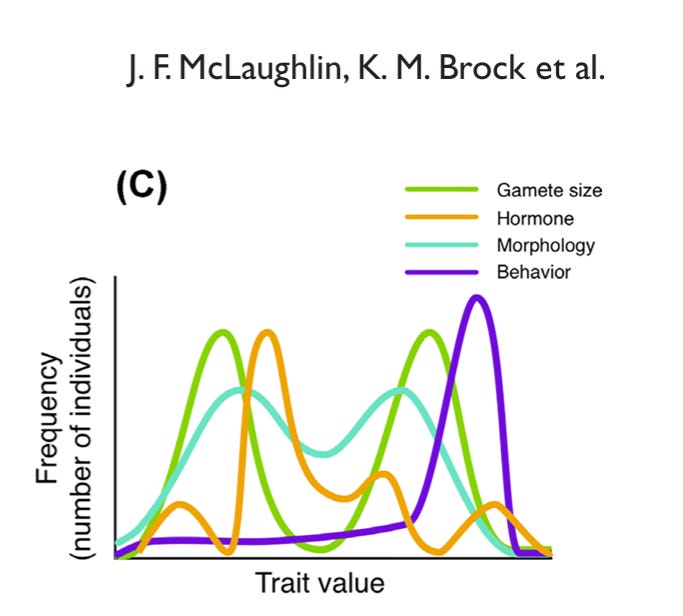Biological truth? WTF? (Part 1)
On sex, gender, men, women, identity, ideology, science and truth
The new Executive Order (EO) signed on January 20th is deceptively simple (with an emphasis on deceptively). There is something called sex, defined as “an individual’s immutable biological classification as either male or female”. There are males. There are females. There are men and boys. There are women and girls. And there are small reproductive cells and large ones. This is “the biological truth”. Women and girls are females. Men and boys are males. And (drum roll please) the EO asserts that males are people who at conception belong to the sex that produces small reproductive cells and females are people who at conception belong to the sex that makes large reproductive cells.1
It’s simple. Except. What happened to chromosomes? What happened to hormones? Or to gonads (the place where those big or small reproductive cells are made)? Or to genitalia—the organs that bring those big or small reproductive cells near enough to one another for conception— when people, well have sex. And what happened to identity—that interior conviction that one is a particular sex? The binary-two-sexes (small or large reproductive cells)—>males—>men/boys (or ditto for females—>women/girls) only works if you ignore such biological realities.
But all these things do exist and they are not immutable. They change during development (from conception until death) and they don’t fit into neat little boxes. That is the biological truth.
The model of sex presented in the Executive Order looks something like this: male and female are strictly either/or (binary).2 There is no overlap and the sex category is aways clear. Except for people who don’t have any developed reproductive cells, this classification system works for a trait such as reproductive cell size. But it fails for many other aspects of biological sex. The authors of the new Executive Order chose this strict binary model as a foundation for social policy. I would not be going out on a limb to say that most biologists think such an absolute binary model is hopelessly oversimplified at best, flat-out wrong at worst.

In fact, biologists today propose something more intricate, and to my mind far more beautiful. (Think of a cloth with two round holes in it versus a piece of intricate, delicate lace.)3 This next image better represents human variation as it actually exists. Look at the green line first. That represents gamete size, and sure enough it is binary. People with mature sex cells generally fall into one of two categories in terms of the size of these reproductive cells.
Next look at the blue-green line which represents morphology. Morphology can refer to a range of traits from external genitalia, to body shape, to breast size, etc. This line looks binary-ish, with two different frequency bumps. But there are also a lot of people inbetween.
Matters become distinctly non-binary when we examine the yellow line, which represents hormones. First, there are no sex-specific reproductive hormones. The same hormone can have different functions in different bodies and may be manufactured in different cells. Hormone levels and patterns of manufacture, however, do differ from one person to another. Some hormones wax and wane on a monthly cycle, others have a daily rhythm. Some respond to stress levels, and most decline with age.
Finally, take a look at the purple line. This one is what scientists call monomorphic (or almost so). Behaviors may differ from one individual to the next, but there are few if any that can reliably mark males as distinct from females.
The scientists who produced the above beautiful, lacy graph presented it as their general model for sex and called it a multivariate model. They believe that working with such a model can “can clarify rather than cloud studies of sexual diversity”.
If this ham-handed model of biological sex were all there were to the EO, I could, at this point, dust off my hands and walk into the sunset. But alas, there is more, as can be seen in the full title: “Defending women from gender ideology extremism and restoring biological truth to federal government”. There are two more definitions in the order—”gender identity” and “gender ideology”. And we need to take a look at these and see how they deploy a biologically unsupported, strict binary model of sex, in an effort to make diversity disapear. So stay tuned for the next episode.
Note the not so gratuitous link to anti-abortion ideology.
The illustrations I use here come from From: McLaughlin JF, Brock KM, Gates I, Pethkar A, Piattoni M, Rossi A, et al. Multivariate Models of Animal Sex: Breaking Binaries Leads to a Better Understanding of Ecology and Evolution. (2023) Integrative and Comparative Biology. 10.1093/icb/icad027
There is so much new and fascinating being published on this at the moment that it is hard to keep up. But here are some examples:
Smiley KO, Munley KM, Aghi K, Lipshutz SE, Patton TM, Pradhan DS, et al. Sex diversity in the 21st century: Concepts, frameworks, and approaches for the future of neuroendocrinology. Hormones and Behavior. 2024;157:105445.
Velocci B. The history of sex research: Is "sex" a useful category? Cell. 2024;187(6):1343-1346.
Griffiths PE. What are biological sexes. 2021.
Ah-King M. The Female Turn: How evolutionary science shifted perceptions about females. Singapore: Palgrave Macmillan; 2023.




